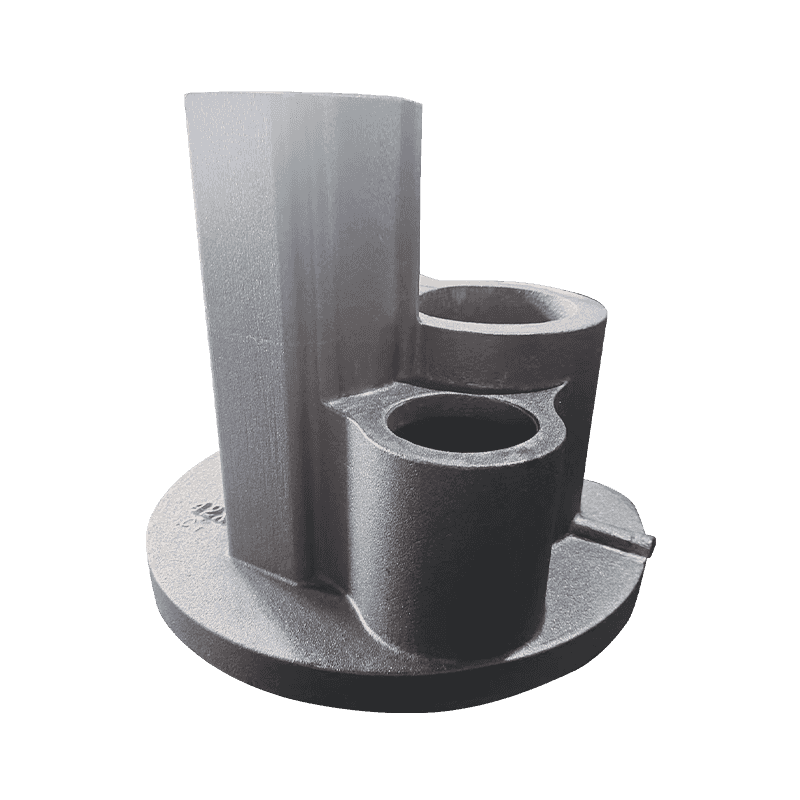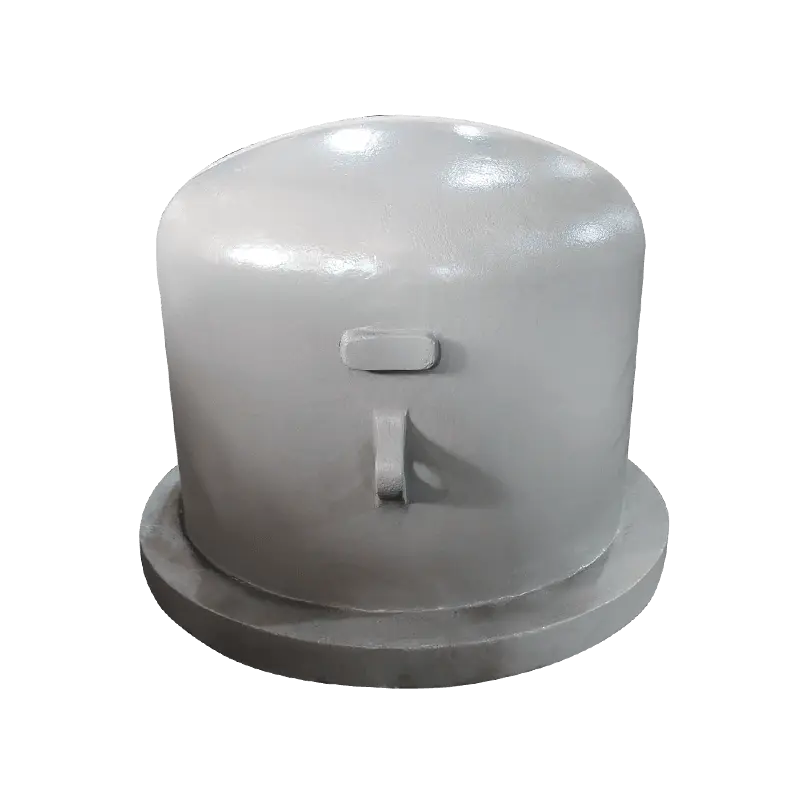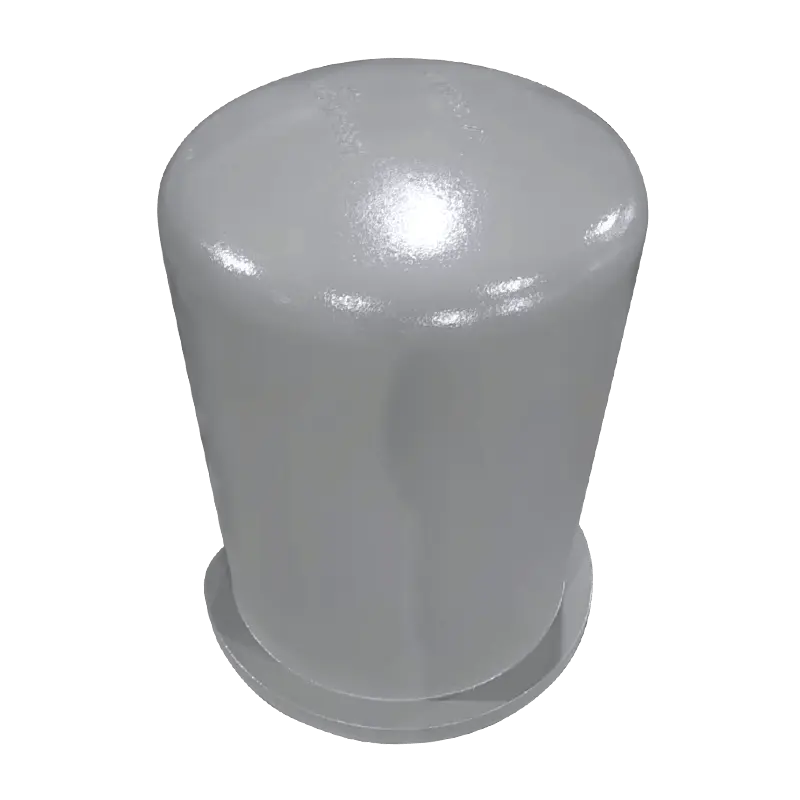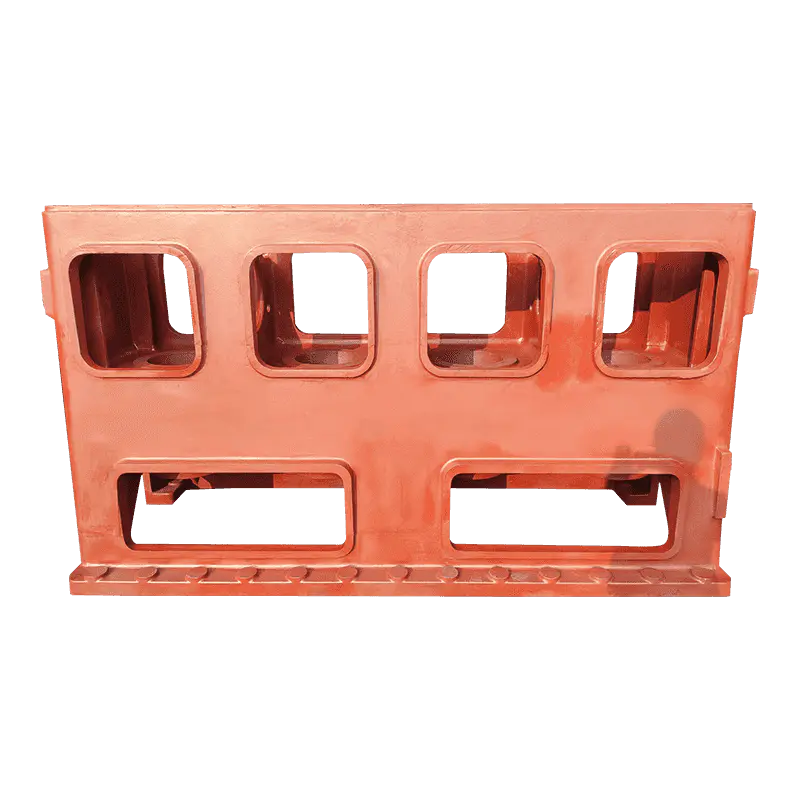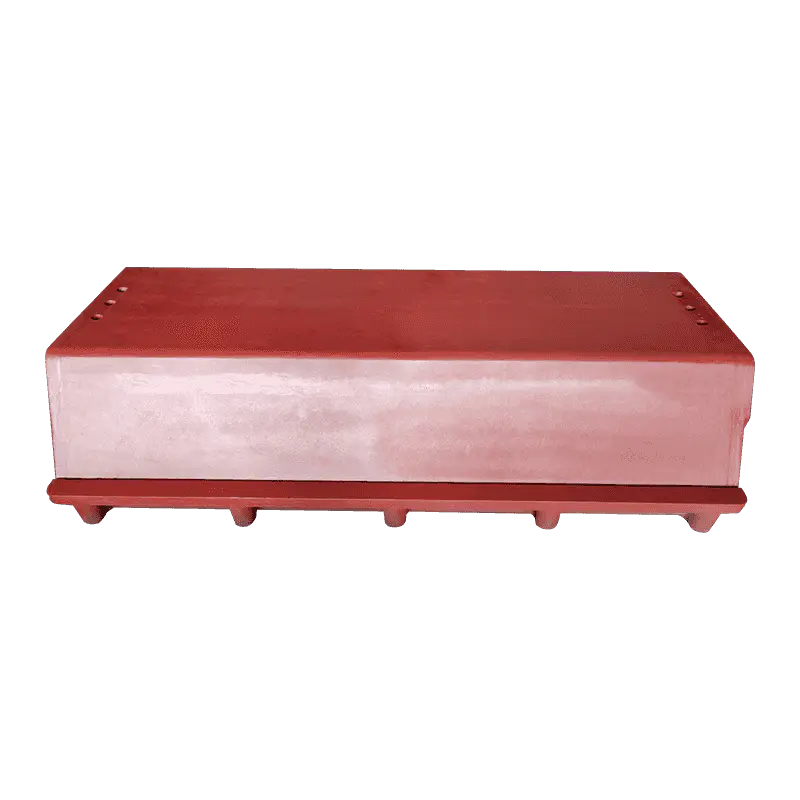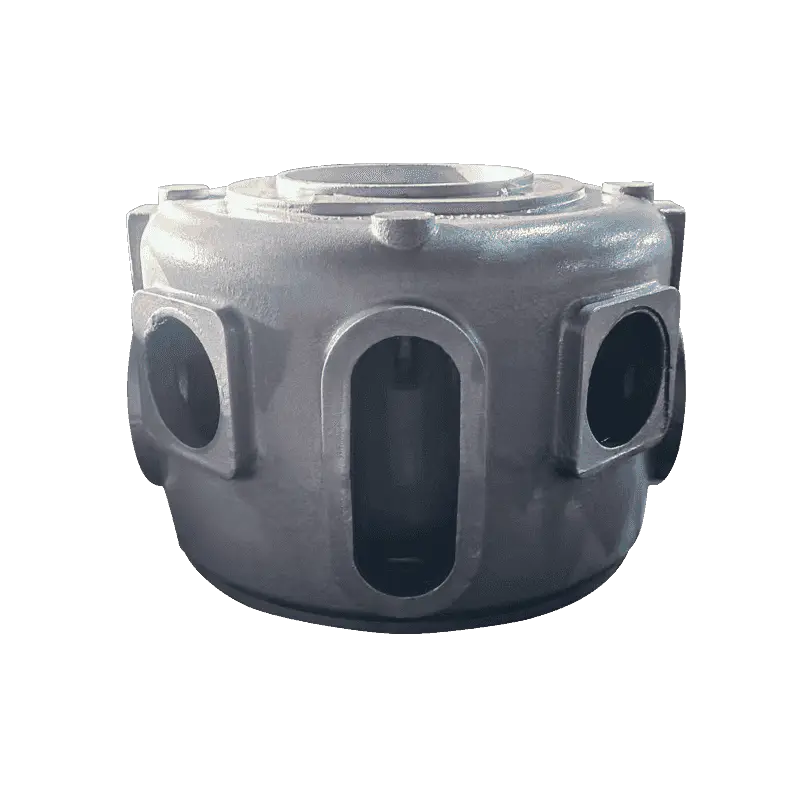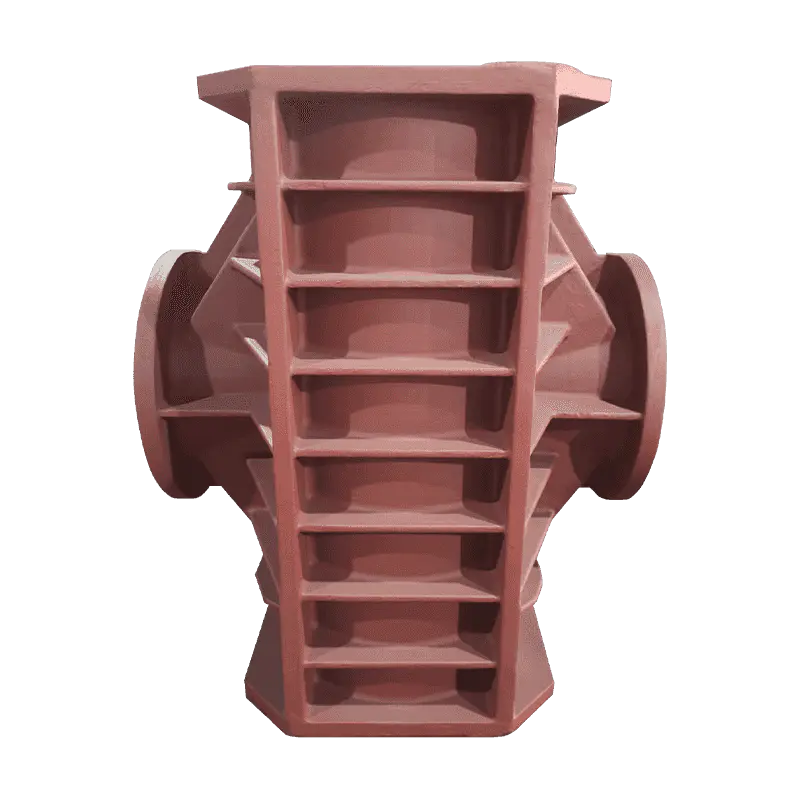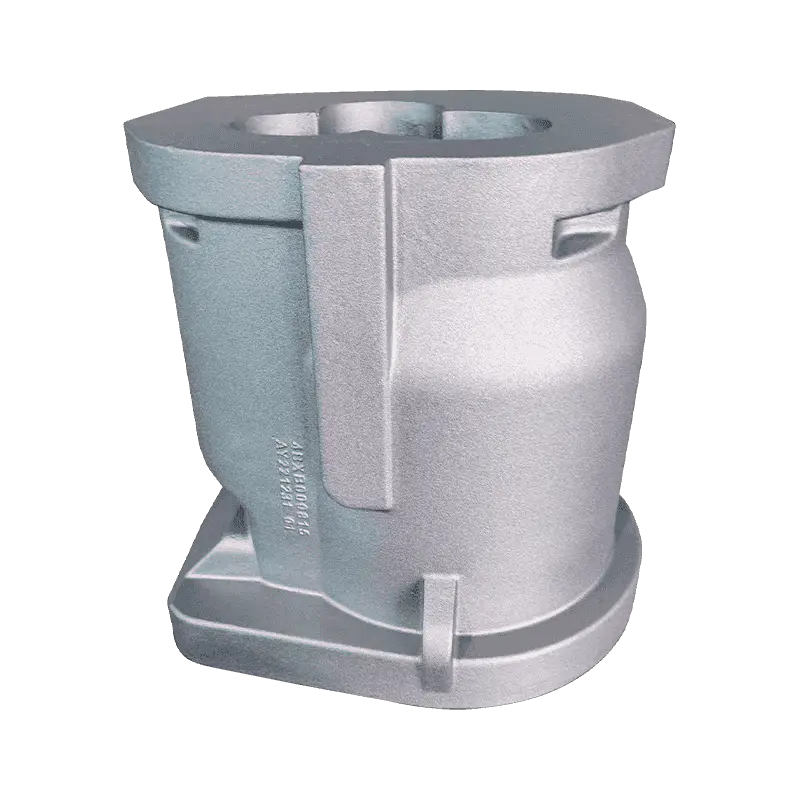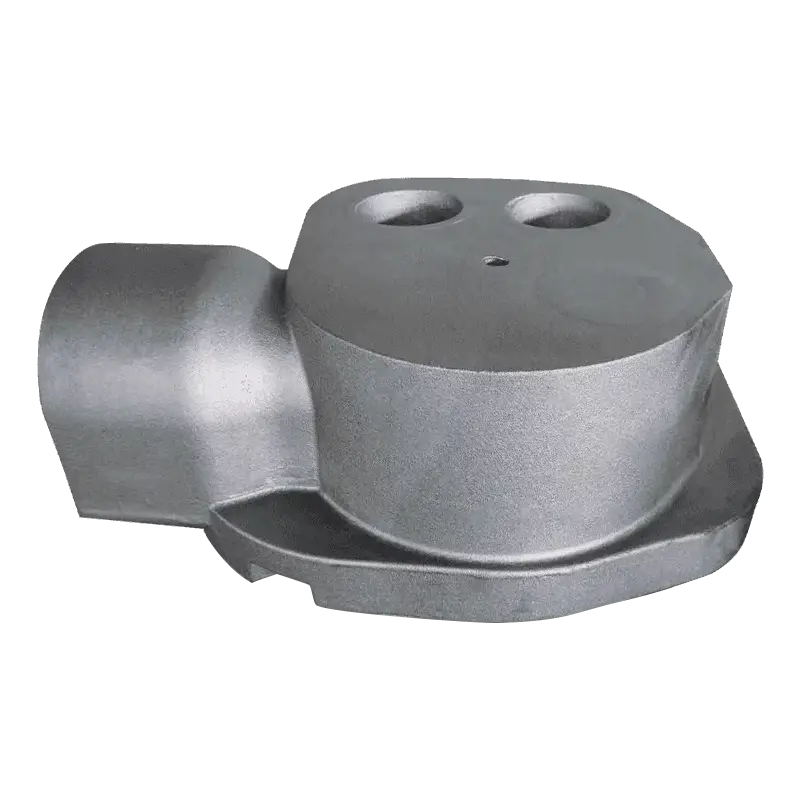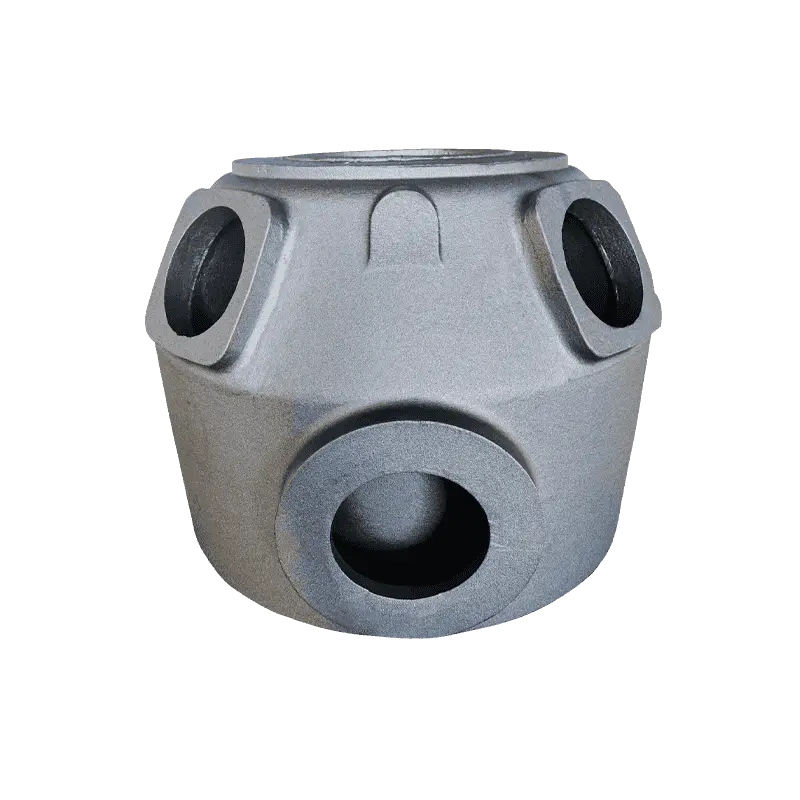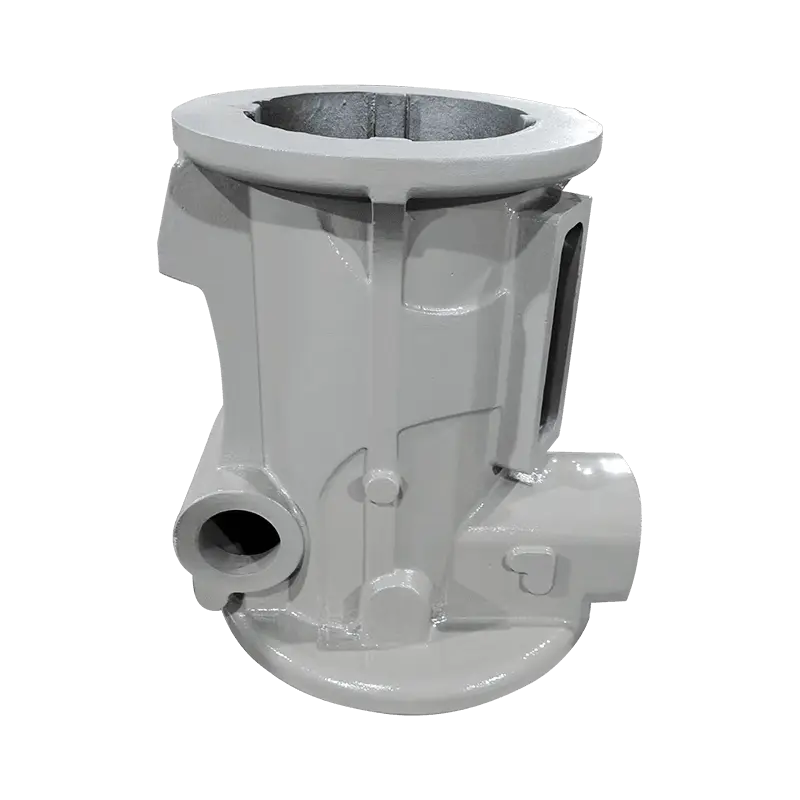Construction Machinery Castings in Excavator and Loader Components
Construction machinery castings play a pivotal role in the design, durability, and performance of excavator and loader components, serving as the backbone of modern construction and earthmoving equipment. These components are subject to extreme mechanical stresses, abrasive conditions, and variable loadings, making the selection of appropriate casting materials and manufacturing methods critical. Excavators and loaders rely heavily on robust, precisely engineered castings for both structural integrity and functional efficiency.
In excavators, the main structures that depend on construction machinery castings include the boom, arm, bucket, house frame, and counterweight. The boom and arm are typically fabricated using high-strength cast steel or ductile iron, providing the necessary combination of tensile strength, toughness, and fatigue resistance to withstand repeated lifting and digging cycles. The casting process for these components often involves sand casting, which allows for complex geometries, internal cavities, and precise dimensional tolerances. By employing foundry techniques such as controlled cooling, riser placement, and gating design, manufacturers ensure the elimination of defects like porosity or shrinkage, which could compromise the structural performance of the machinery.
The bucket is another critical component made from construction machinery castings. Buckets are exposed to constant abrasive wear as they dig through soil, rock, or gravel. Using high-chromium cast irons or alloyed steels enhances wear resistance while maintaining sufficient impact toughness. Modern foundries often employ heat treatment processes, such as tempering and quenching, to further improve the hardness and toughness of these castings. Advanced simulation software is also used during the design phase to predict stress distribution and optimize casting geometry, ensuring that excavator buckets can endure extreme loading without premature failure.
For loaders, the lift arms, loader frames, axle housings, and hydraulic linkages are commonly manufactured using construction machinery castings. Lift arms are subjected to repeated bending and torsional stresses, requiring materials that combine ductility with high tensile strength. Cast steel is often selected due to its excellent fatigue performance and machinability. Similarly, axle housings in loaders, which support the weight of the equipment and resist torsional deformation, are frequently produced using heavy-duty castings. These components must maintain dimensional accuracy to ensure proper alignment with the drive and suspension systems, highlighting the importance of precision in the casting process.
The integration of hydraulic systems into excavators and loaders further underscores the importance of construction machinery castings. Hydraulic cylinders, mounts, and housing units often incorporate cast iron or steel castings to achieve rigidity and stability under high-pressure fluid operation. Hydraulic cylinder bodies require seamless surface finishes and internal consistency, as even minor defects can lead to leaks or catastrophic failures. The foundry process ensures uniform material properties, while subsequent machining operations provide the exact tolerances needed for proper hydraulic operation. Additionally, stress-relief treatments reduce residual stresses introduced during casting, preventing cracking under cyclic hydraulic loads.
Wear-resistant castings are particularly important in components such as excavator teeth, loader edges, and cutting blades. These small but critical parts experience significant abrasive contact and impact during operation. Foundries often employ high-alloy steels or white cast iron for these elements, sometimes incorporating surface hardening techniques to extend service life. The integration of such castings into larger structural components requires precision machining and careful assembly, ensuring compatibility with the mechanical and hydraulic systems of the equipment.
The production of construction machinery castings for excavators and loaders also involves consideration of weight optimization. Heavier castings can increase durability but may reduce efficiency and maneuverability. Therefore, finite element analysis (FEA) is frequently used during the design phase to optimize wall thickness, rib placement, and overall geometry. By doing so, engineers can reduce material usage without compromising strength or fatigue performance. This balance between strength and weight is particularly critical in mobile construction equipment, where fuel efficiency and operational costs are directly affected by the weight of cast components.
In modern manufacturing environments, automation and quality control in foundries have greatly improved the reliability of construction machinery castings. Techniques such as X-ray inspection, ultrasonic testing, and 3D scanning ensure that castings meet stringent quality standards. These methods detect internal flaws, dimensional deviations, and surface irregularities, guaranteeing that excavator and loader components perform reliably under harsh conditions. Furthermore, the integration of computer-aided design (CAD) and computer-aided manufacturing (CAM) allows precise replication of complex shapes, reducing manual errors and improving consistency across production batches.
Another critical aspect is material selection for environmental and operational conditions. Excavators and loaders may operate in extreme temperatures, corrosive soils, or wet conditions. Construction machinery castings often utilize alloyed steels with elements like chromium, molybdenum, and nickel to enhance corrosion resistance and high-temperature strength. Surface coatings, such as epoxy paints or hardfacing materials, further extend the life of these castings, protecting them from wear, oxidation, and chemical exposure during operation.
Maintenance and repair considerations also influence the design and production of construction machinery castings. Modular cast components allow easier replacement of worn or damaged parts, reducing downtime and operational costs. For instance, excavator bucket side cutters and loader edges can be cast as replaceable units, allowing maintenance teams to swap out parts without dismantling entire assemblies. This approach emphasizes the synergy between casting design, material selection, and operational efficiency in heavy construction equipment.
Finally, the evolution of construction machinery castings is closely linked to innovation in manufacturing technology. Advanced additive manufacturing techniques are beginning to complement traditional casting methods, enabling the production of highly complex geometries and reducing lead times. Similarly, improvements in alloy compositions, heat treatment processes, and simulation-driven design allow foundries to produce components that meet increasingly demanding performance requirements. These innovations enhance the durability, reliability, and efficiency of excavators and loaders, demonstrating the indispensable role of construction machinery castings in modern heavy equipment manufacturing.


Construction Machinery Castings for Heavy-Duty Crane Structures
Construction machinery castings are indispensable in the manufacture of heavy-duty crane structures, forming the backbone of modern lifting and material handling equipment. Cranes, whether tower cranes, mobile cranes, or crawler cranes, require components that can withstand immense mechanical stress, cyclic loading, and environmental challenges over extended periods of operation. The reliance on cast components ensures structural integrity, precision alignment, and longevity, while also enabling complex geometries that are difficult or impossible to achieve with forged or fabricated parts.
In the design of heavy-duty crane structures, several critical components are produced through construction machinery castings. These include the crane base, slewing rings, boom sections, counterweight housings, gear housings, and hydraulic mounts. The crane base serves as the primary structural support and must endure vertical and horizontal loads, as well as torsional forces induced during lifting operations. Foundries typically employ high-strength cast steels or ductile iron to produce bases capable of withstanding these extreme forces. Sand casting is often utilized for such large and complex parts due to its versatility, allowing for the inclusion of internal ribbing and reinforcement features that enhance rigidity without excessive weight.
The slewing ring components, which allow cranes to rotate smoothly under heavy loads, rely on precise construction machinery castings to maintain alignment and performance. These castings are subject to high compressive stress and require excellent wear resistance. Alloyed cast steels with controlled carbon and alloying element content are commonly selected to achieve the necessary hardness, toughness, and fatigue resistance. During production, foundry engineers must carefully control the cooling rates and employ risers and gating systems that minimize internal porosity or segregation, which could compromise the structural performance of the slewing rings.
Boom sections represent another critical application of construction machinery castings in crane structures. Booms are often modular, and the larger sections are manufactured using heavy-duty castings to provide sufficient strength while allowing for the assembly of telescopic or lattice structures. These castings are exposed to high bending moments and must be resistant to fatigue failure over long operational cycles. Advanced finite element analysis (FEA) is frequently applied to simulate stress distribution, optimize rib placement, and determine wall thicknesses. Such analyses guide foundry processes, ensuring that each casting maintains structural integrity under dynamic loading conditions while minimizing unnecessary weight.
Counterweight housings and support structures also depend heavily on construction machinery castings. These components provide stability to cranes by balancing the load lifted by the boom. Castings used in counterweights often incorporate dense metals or specialized alloys to achieve high mass in a compact volume, ensuring that cranes remain stable during lifting operations. Precision machining of these castings is critical to ensure proper interfacing with the crane chassis and attachment points, while heat treatment may be applied to enhance surface hardness and prevent deformation under continuous stress.
Gear housings in cranes, particularly those that house slewing gears or hoisting mechanisms, rely on construction machinery castings for rigidity and wear resistance. These housings must maintain precise alignment of gears, shafts, and bearings to ensure smooth transmission of mechanical power. High-strength cast steel or gray cast iron with superior vibration-damping properties is commonly selected. The foundry process must eliminate internal defects and maintain dimensional accuracy, as even minor deviations can lead to excessive gear wear, noise, and reduced efficiency. Advanced inspection techniques such as ultrasonic testing, X-ray inspection, and 3D laser scanning are often employed to verify the integrity and dimensions of the cast components.
Hydraulic system mounts and cylinder housings in crane structures also utilize construction machinery castings due to the requirement for high stiffness and precise mounting surfaces. Hydraulic cylinders are subject to high internal pressures, and the cast housings must maintain dimensional stability under cyclic loading. Alloyed castings combined with surface finishing techniques ensure that the hydraulic components operate reliably over extended periods, even under challenging construction site conditions. Proper stress-relief procedures, including controlled cooling and tempering, reduce residual stresses introduced during casting, preventing cracking during operation.
The manufacturing process for heavy-duty crane castings involves multiple critical steps. First, pattern design must consider shrinkage allowances, draft angles, and the positioning of cores for internal features. Sand molds are often reinforced with binders to withstand the thermal and mechanical stresses of molten metal pouring. Molten alloyed steel or ductile iron is then poured under controlled conditions to ensure uniform filling and minimal turbulence, reducing the likelihood of inclusions or voids. Post-casting, components undergo heat treatment, stress-relief, and precision machining to achieve the required tolerances and mechanical properties.
Wear resistance and fatigue performance are essential considerations for construction machinery castings in crane structures. Components such as slewing bearings, pivot points, and pin mounts are exposed to high repetitive loads and abrasive environmental conditions. Selection of high-chromium alloys or addition of surface hardening treatments enhances the durability of these castings. Regular inspection and maintenance protocols are also informed by the casting design, enabling modular replacement of critical components and minimizing downtime in crane operation.
Weight optimization in crane castings is crucial to maximize lifting capacity without compromising safety. Excessive weight in the structural components can reduce crane efficiency and maneuverability. By employing finite element analysis, foundries and design engineers optimize wall thickness, internal ribbing, and reinforcement structures to balance strength and weight. Modern design software allows for iterative simulations, ensuring that construction machinery castings meet both performance and operational efficiency requirements.
Advances in foundry technology have significantly improved the consistency, precision, and reliability of crane castings. Automation in molding, pouring, and finishing reduces variability, while quality control systems such as real-time temperature monitoring and automated inspection ensure that each casting meets stringent standards. The integration of computer-aided design (CAD) and computer-aided manufacturing (CAM) allows complex geometries to be replicated with high accuracy, providing predictable performance in the final crane assembly.
Environmental considerations also influence the production of heavy-duty crane castings. Foundries are increasingly adopting cleaner processes, recycling sand and metal scrap, and reducing emissions during casting. Alloy selection and surface treatments are optimized not only for performance but also for longevity, reducing the frequency of replacements and the environmental footprint of crane operations.
The role of construction machinery castings in crane structures extends beyond mere load-bearing. Properly engineered castings enhance dynamic performance, absorb vibrations, and maintain alignment of critical mechanical systems. The synergy between material science, casting technology, and precision engineering ensures that cranes operate efficiently, safely, and reliably under demanding construction site conditions, demonstrating the indispensable contribution of cast components to modern heavy-duty lifting equipment.

Construction Machinery Castings in Bulldozer Frames and Chassis
Construction machinery castings play a fundamental role in the fabrication of bulldozer frames and chassis, providing the necessary structural integrity and mechanical durability required for heavy-duty earthmoving operations. The bulldozer, as a primary piece of construction and mining equipment, operates under extremely high loads, repetitive impacts, and harsh terrain conditions. Every major structural component, from the main frame to roller brackets, engine mounts, and track supports, often relies on precisely engineered cast components to meet these operational demands.
The main frame of a bulldozer is the primary load-bearing structure and serves as the backbone that connects all functional elements, including the engine, transmission, hydraulic systems, and undercarriage. Manufacturing this component from construction machinery castings ensures superior strength, torsional rigidity, and resistance to fatigue failure. Materials such as ductile iron, alloyed cast steel, and sometimes high-strength gray cast iron are selected based on their mechanical properties, including yield strength, impact toughness, and wear resistance. The design of the main frame must also consider stress distribution, as bulldozers frequently operate on uneven terrain and encounter point loads from rocks and other obstacles.
Bulldozer chassis components, such as roller frames, track guards, and engine mounting brackets, are similarly produced using construction machinery castings. These components endure repeated vibration, torsion, and shear forces. For example, track roller brackets, which support the rollers that guide the tracks, must resist significant bending and compressive forces. Using high-strength cast steel allows these parts to maintain dimensional accuracy under load, reducing the risk of misalignment or premature wear. Foundries employ sand casting or investment casting techniques to produce these parts, carefully controlling the cooling rate and gating systems to avoid internal defects such as porosity or segregation.
Engine mounts and transmission housings within bulldozers rely heavily on construction machinery castings to maintain precise alignment of mechanical systems. Misalignment can cause accelerated wear, vibration, and even catastrophic mechanical failure. Foundries often combine heat treatment processes such as tempering and stress-relieving with precision machining to achieve tight tolerances and uniform material properties. The choice of cast steel alloys or ductile iron for these components ensures both rigidity and the ability to absorb operational vibrations without cracking.
The blade mounting assembly, a critical interface between the bulldozer and the material it moves, is also fabricated using construction machinery castings. The assembly must endure high-impact loads, torsional stresses, and abrasive wear as the blade engages with soil, rocks, and debris. High-chromium alloys or surface-hardened cast components are frequently used to enhance abrasion resistance while maintaining sufficient toughness to prevent brittle failure. Modern foundries often incorporate finite element analysis (FEA) during the design phase to predict stress concentrations and optimize rib placement, wall thickness, and overall geometry of the blade mounts.
The undercarriage components, including track frames, idlers, and sprockets, are other areas where construction machinery castings are indispensable. Track frames support the weight of the bulldozer and must withstand dynamic loads while maintaining alignment of the tracks over uneven terrain. The use of cast steel or ductile iron ensures high fatigue resistance and dimensional stability. These castings often undergo precision machining to maintain exact interfaces with roller shafts and track pins. Surface treatments, such as carburizing or hardfacing, further enhance wear resistance for extended operational life.
Hydraulic cylinder mounts and linkage brackets are essential for controlling the movement of the blade, ripper, and other attachments. These components experience high-pressure loads and repetitive motion, making the selection of construction machinery castings with high toughness and dimensional stability crucial. The foundry process involves careful mold design, gating system optimization, and controlled cooling to prevent internal stresses or defects. Post-casting machining and heat treatment processes refine tolerances and improve surface hardness to meet precise hydraulic interface requirements.
Weight distribution and structural optimization are critical considerations in bulldozer frame and chassis design. Excessive weight can reduce mobility and increase fuel consumption, while insufficient strength may lead to component failure. Finite element modeling is widely used to simulate load distribution, identify stress hotspots, and guide the design of construction machinery castings that balance strength and weight. Strategic placement of ribs, gussets, and internal cavities in cast frames allows for material savings without compromising performance or safety.
Wear resistance and fatigue performance are also key for bulldozer components fabricated from construction machinery castings. Operational conditions often involve abrasive soil, rocks, and debris, combined with cyclic loading. High-alloy steels, white cast iron, and surface-hardened castings are commonly employed to extend service life. Critical components such as roller brackets, blade mounts, and ripper assemblies are subjected to hardness testing and non-destructive evaluation (NDE) methods like ultrasonic inspection and X-ray imaging to ensure defect-free castings capable of sustaining extreme operational stress.
Precision in machining and assembly is another significant advantage of using construction machinery castings in bulldozer frames and chassis. The interfaces between cast components, such as track frames and roller mounts, must align perfectly to maintain smooth track operation and prevent excessive wear. Advanced computer-aided design (CAD) and computer-aided manufacturing (CAM) allow foundries to replicate complex geometries accurately, producing castings that require minimal post-casting modifications while ensuring consistent performance across production batches.
Environmental and operational conditions also dictate material and design choices for bulldozer castings. Operating in wet, cold, or corrosive environments requires castings with adequate corrosion resistance and the ability to retain mechanical properties at low temperatures. Alloy selection, heat treatment, and protective coatings are carefully considered to ensure longevity and reliability. Foundries may also implement recycling of scrap metal and sand, reducing environmental impact while producing durable cast components for heavy-duty machinery.
Maintenance and modularity considerations influence the design of bulldozer castings. Components like blade mounts, roller brackets, and track supports are designed to be replaceable, enabling maintenance teams to swap worn or damaged parts without dismantling the entire machine. Modular castings improve operational uptime and reduce maintenance costs while maintaining the structural integrity and performance of the bulldozer.
The evolution of construction machinery castings for bulldozer frames and chassis is closely linked to advancements in foundry technology, material science, and simulation-driven design. Automated mold handling, real-time process monitoring, and high-precision casting techniques have enhanced the consistency and reliability of critical components. Advanced alloys, surface treatments, and optimized geometric design contribute to improved strength, fatigue resistance, and wear performance. These innovations ensure that bulldozers, even under extreme operational conditions, continue to deliver high performance, reliability, and safety.

Construction Machinery Castings for Concrete Mixer and Pump Parts
Construction machinery castings are essential in the manufacturing of concrete mixer and pump parts, providing the structural strength, durability, and precision required for high-performance operation in the construction industry. Concrete mixers and pumps are subjected to extreme abrasive wear, continuous cyclic loading, and exposure to harsh chemical environments. These conditions necessitate the use of high-quality cast components to ensure longevity, operational efficiency, and safety.
In concrete mixers, drum shells, gear housings, paddles, and chutes are typically produced using construction machinery castings. The drum shell, which rotates continuously to mix concrete, must withstand high rotational forces and abrasive contact with aggregates and cement. Materials such as high-chromium cast iron, ductile iron, or alloyed cast steel are commonly used. These materials combine toughness, wear resistance, and dimensional stability, ensuring that the drum maintains its shape and performance over prolonged use. The casting process for drum shells often involves sand casting due to the large size and complex geometry, allowing for precise thickness control and inclusion of reinforcing ribs for structural rigidity.
Paddles inside the concrete drum are critical for efficient mixing. They are constantly subjected to abrasive forces from sand, gravel, and cement particles. Using high-hardness castings enhances wear resistance while maintaining impact toughness. The design of these cast paddles is optimized using finite element analysis (FEA) to ensure even stress distribution and to prevent premature deformation or cracking during operation. Foundries often employ heat treatment processes such as tempering or quenching to increase hardness and improve fatigue resistance.
Gear housings in concrete mixers and pumps are another application of construction machinery castings. These housings support heavy-duty gears and shafts, ensuring smooth power transmission from the engine or motor to the mixer drum or pump mechanism. The materials chosen for these castings must resist wear, vibration, and thermal expansion, which can impact gear alignment and operational efficiency. Ductile iron or cast steel alloys are typically selected for their combination of rigidity and shock absorption. The foundry process must control cooling rates and gating design carefully to avoid porosity and internal defects that could compromise mechanical performance under high loads.
In concrete pumps, piston cylinders, valve housings, manifolds, and delivery chutes are manufactured using construction machinery castings. Piston cylinders are subjected to high-pressure hydraulic operation and repetitive motion, requiring castings with exceptional dimensional stability and toughness. Alloyed cast steel or high-strength ductile iron is commonly employed, with surface hardening applied to resist wear from sliding components and abrasive concrete mixtures. Precision machining after casting ensures tight tolerances, which are critical for maintaining hydraulic efficiency and preventing leakage.
Valve housings in concrete pumps control the direction and flow of concrete under high pressure. These components experience extreme wear due to the abrasive nature of the concrete mixture, combined with cyclic hydraulic forces. Construction machinery castings made from wear-resistant alloys, such as chromium-molybdenum steels, are used to extend service life. Foundries must carefully monitor casting parameters to ensure uniform material properties, eliminate internal defects, and achieve precise dimensional tolerances. Post-casting heat treatment enhances hardness and fatigue resistance, ensuring reliable operation under high-stress conditions.
Manifolds in concrete pumps distribute the flow of concrete to various delivery points. These components are designed using construction machinery castings to withstand pressure pulsations, abrasive wear, and chemical exposure from cementitious materials. The castings must maintain dimensional accuracy to ensure proper fitment with pipes, flanges, and other hydraulic components. Foundry engineers often use computer-aided design (CAD) and simulation tools to optimize the geometry for both performance and manufacturability, considering factors such as flow turbulence, stress distribution, and material thickness.
Delivery chutes and hopper components in concrete mixers and pumps also rely on construction machinery castings due to high abrasion and impact from concrete flow. High-chrome cast iron or alloyed steel castings provide superior wear resistance while maintaining sufficient toughness to prevent cracking. The casting process for these parts often involves sand molding with reinforced cores to achieve precise shapes and internal cavities. Surface finishing processes, such as grinding or polishing, reduce friction and improve the flow characteristics of concrete, minimizing material blockage and wear.
The integration of hydraulic systems in concrete mixers and pumps further emphasizes the role of construction machinery castings. Hydraulic cylinder mounts, frame supports, and linkage brackets are fabricated from cast steel or ductile iron, providing the necessary rigidity to handle high-pressure operation. The castings must absorb vibrations, resist deformation, and maintain alignment to ensure the efficiency of the hydraulic system. Controlled cooling and stress-relief treatments during the casting process reduce the risk of cracking, warping, or residual stresses that could compromise component performance.
Weight optimization and structural efficiency are important considerations for concrete mixer and pump castings. Excessive weight can increase fuel consumption, reduce maneuverability, and impact transportability on construction sites. Finite element analysis and topology optimization are employed to design castings that maintain strength and durability while minimizing unnecessary mass. Strategic placement of ribs, gussets, and material redistribution allows components to resist bending and torsion without excessive material use, enhancing operational efficiency and reducing production costs.
Quality control is a critical aspect of producing construction machinery castings for concrete mixers and pumps. Advanced inspection methods, including ultrasonic testing, X-ray inspection, and 3D scanning, ensure that castings meet stringent dimensional and structural standards. Consistent control over alloy composition, pouring temperature, and cooling rate ensures uniform mechanical properties and minimizes defects such as inclusions, shrinkage, or cracks. Precision machining after casting guarantees proper fitment and reliable performance in the final assembly.
Environmental and operational factors also influence the design and material selection of concrete mixer and pump castings. Components must resist corrosion, chemical exposure, and temperature fluctuations encountered during construction site operations. Alloyed steels, protective coatings, and surface hardening techniques are used to extend component lifespan and maintain performance under challenging conditions. Recycling of sand and metal scrap within foundries contributes to sustainable production practices without compromising the quality of castings.
Maintenance and modular design considerations affect concrete mixer and pump castings. Many cast components are designed to be replaceable, such as wear plates, paddles, or valve components, allowing maintenance teams to swap worn parts without dismantling entire systems. This modular approach reduces downtime, extends operational life, and improves cost-efficiency while preserving the reliability and structural integrity of the machinery.
Advances in foundry technology and materials science continue to improve the performance of construction machinery castings in concrete mixers and pumps. Innovations such as additive manufacturing for mold production, computer-aided casting simulation, and advanced heat treatment enable the creation of complex geometries with optimized mechanical properties. These technological improvements result in cast components that are stronger, more wear-resistant, and capable of performing under increasingly demanding construction conditions, ensuring the efficient and reliable operation of concrete mixers and pumps.
Construction Machinery Castings in Hydraulic System Housings
Construction machinery castings are integral to the manufacture of hydraulic system housings, which are essential components in modern heavy-duty machinery. Hydraulic systems provide the power and precision required for lifting, digging, and material handling operations in equipment such as excavators, loaders, cranes, and bulldozers. The housings that contain hydraulic pumps, motors, cylinders, and valves must withstand high internal pressures, mechanical stress, and dynamic forces while maintaining dimensional accuracy and reliability. The use of cast components ensures that these housings meet stringent performance requirements, combining structural strength, wear resistance, and precise machining capabilities.
The primary function of a hydraulic system housing is to provide a stable enclosure for internal components while transmitting and supporting mechanical loads. Components such as pump bodies, valve blocks, cylinder mounts, and manifold housings are commonly fabricated using construction machinery castings. These parts must maintain tight tolerances to prevent fluid leakage, ensure smooth operation of pistons and valves, and resist deformation under high pressure. Materials such as ductile iron, cast steel, and high-strength alloyed steels are frequently selected due to their ability to withstand both static and dynamic loads, as well as their compatibility with hydraulic fluid properties.
Pump housings are among the most critical applications of construction machinery castings in hydraulic systems. Hydraulic pumps convert mechanical energy into fluid energy, and the housing must maintain precise alignment of gears, pistons, or rotors. Misalignment or structural deformation can lead to reduced efficiency, increased wear, and potential system failure. Castings made from high-strength steel alloys are used to provide rigidity and resist internal pressure. The casting process often involves sand or investment casting, which allows for complex internal cavities and precise dimensional control. After casting, heat treatment such as stress-relief or tempering ensures uniform mechanical properties and minimizes residual stresses that could lead to cracking under high-pressure operation.
Cylinder mounts and end caps are additional hydraulic housing components that rely on construction machinery castings for their performance. These parts endure both axial and radial loads during cylinder extension and retraction. The castings must be tough enough to absorb impact from sudden load changes and resistant to fatigue from repeated cycles. Surface treatments or hardening techniques are often applied to the mounting faces and internal bearing surfaces to enhance wear resistance and prolong operational life. Precision machining of the cast housings ensures alignment with pistons, rods, and seals, reducing leakage and maintaining system efficiency.
Valve blocks and manifold housings are complex cast components that direct fluid flow within hydraulic systems. These housings contain multiple internal channels, ports, and cavities that must be manufactured with high precision. Construction machinery castings allow foundries to produce these intricate geometries in a single piece, reducing assembly complexity and potential leak paths. Materials such as alloyed cast steels or ductile iron provide the necessary combination of strength, toughness, and corrosion resistance. Advanced simulation tools, including computational fluid dynamics (CFD), are often used in conjunction with finite element analysis (FEA) to optimize internal flow paths, minimize turbulence, and reduce stress concentrations in critical regions of the casting.
The abrasive nature of hydraulic fluids containing particulate matter, combined with high operating pressures, demands exceptional wear resistance for hydraulic housings. Components exposed to sliding or rotating parts, such as cylinder bore surfaces, are often manufactured using high-chromium cast irons or treated with surface hardening techniques to reduce wear. Foundries carefully control alloy composition, pouring temperature, and cooling rates to ensure uniform microstructure and mechanical properties throughout the casting. Non-destructive testing methods, such as ultrasonic inspection or X-ray scanning, are commonly applied to detect internal defects and ensure reliability under extreme operational conditions.
Thermal considerations are also critical in hydraulic housing design. Hydraulic systems generate significant heat during operation, and the cast housings must maintain dimensional stability and mechanical strength across a range of temperatures. Materials are selected for their thermal conductivity, expansion characteristics, and ability to resist distortion. In some cases, cast housings are designed with integrated cooling channels to manage heat dissipation effectively. The combination of optimized geometry, appropriate alloy selection, and heat treatment ensures that construction machinery castings maintain performance even under prolonged high-temperature operation.
Weight optimization in hydraulic system castings is essential for mobile machinery. Excessively heavy castings can reduce equipment efficiency and maneuverability, while insufficiently strong components may fail under operational loads. FEA and topology optimization techniques are used to design castings that maintain strength and rigidity while minimizing mass. Internal ribs, gussets, and material redistribution allow the housings to resist bending and torsion without unnecessary weight, contributing to energy efficiency and improved performance of construction machinery.
Hydraulic housings are subject to both mechanical and chemical stresses. Contact with hydraulic fluids, lubricants, and environmental contaminants requires castings to be corrosion-resistant and chemically stable. Protective coatings, plating, or surface treatments are often applied to extend service life. Additionally, modularity and maintenance considerations influence casting design. Components are often manufactured as replaceable units, such as removable valve blocks or cylinder end caps, enabling rapid maintenance without disassembling entire systems. This modular approach enhances operational uptime and reduces maintenance costs.
The foundry process for hydraulic system castings includes pattern and mold design, alloy selection, controlled pouring, and post-casting treatments. Sand or investment molds are reinforced to handle high-temperature molten metal and intricate geometries. Gating systems are optimized to ensure uniform filling and minimal turbulence, preventing defects such as porosity, shrinkage, or cold shuts. After casting, machining and precision finishing refine critical surfaces to meet exact tolerances, ensuring compatibility with internal hydraulic components. Advanced inspection techniques confirm that all castings meet mechanical and dimensional specifications.
Innovations in casting technology continue to enhance the quality and performance of hydraulic system housings. Additive manufacturing techniques for mold design, simulation-driven casting optimization, and advanced alloy development allow for more complex geometries, improved material properties, and higher production consistency. These innovations increase the durability, precision, and reliability of construction machinery castings, ensuring that hydraulic systems in heavy-duty equipment can operate efficiently under demanding conditions.
The integration of construction machinery castings in hydraulic system housings has transformed the performance and reliability of modern construction machinery. By combining high-strength materials, precise casting techniques, heat treatment, and advanced design optimization, manufacturers produce components capable of withstanding extreme pressures, repeated cyclic loads, and harsh environmental conditions. These cast housings provide the foundation for hydraulic systems that deliver power, precision, and longevity in equipment such as excavators, loaders, bulldozers, and cranes, demonstrating the indispensable role of construction machinery castings in contemporary heavy machinery design.
Construction Machinery Castings for Mining and Earthmoving Equipment
Construction machinery castings are essential in the design and manufacturing of components for mining and earthmoving equipment, where operational demands include extreme loads, abrasive environments, and continuous cyclic stresses. Equipment such as excavators, bulldozers, wheel loaders, draglines, and mining shovels relies heavily on cast components for structural integrity, wear resistance, and precise mechanical performance. The use of castings in these machines enables engineers to produce parts with complex geometries, high dimensional accuracy, and enhanced durability, ensuring efficient operation under severe conditions.
One of the primary applications of construction machinery castings in mining and earthmoving equipment is the structural frame and chassis components. Main frames, undercarriage supports, and track assemblies must endure heavy loads while maintaining alignment under constant vibration and torsional stress. Ductile iron, cast steel, and high-strength alloyed steels are frequently selected due to their combination of toughness, tensile strength, and fatigue resistance. The casting process, often using sand casting or investment casting, allows for the incorporation of reinforcing ribs and complex internal geometries, improving strength while reducing unnecessary weight. These castings are subject to heat treatment and stress-relief procedures to ensure dimensional stability and uniform mechanical properties.
Bucket assemblies, loader arms, and shovel linkages are other critical areas where construction machinery castings are indispensable. Buckets used in mining operations endure extreme abrasive wear from rock, gravel, and mineral ores. Castings made from high-chromium alloys, white cast iron, or alloyed steel are utilized to resist surface degradation while maintaining toughness. Linkage components, such as loader arms or shovel arms, experience high bending moments and torsional loads. Finite element analysis (FEA) is commonly employed to optimize material distribution, rib placement, and wall thickness, ensuring that cast components withstand repetitive loading cycles without failure.
Undercarriage components, including track frames, roller brackets, and sprocket housings, benefit from the use of construction machinery castings due to their ability to maintain precise alignment under heavy loads. Track frames must resist bending and torsional stress while supporting the weight of the machinery and transferred loads from the bucket or blade. Roller brackets and sprocket housings endure continuous friction and impact forces, requiring castings with high hardness and wear resistance. Surface treatments, such as hardfacing, and careful alloy selection further enhance the durability of these components, extending operational life in abrasive conditions.
Hydraulic system integration in mining and earthmoving equipment emphasizes the importance of cast housings and mounts. Hydraulic cylinder bodies, mounts, and manifold housings are commonly fabricated using construction machinery castings. These castings must withstand high pressures, cyclic loading, and mechanical stresses. Materials such as ductile iron and cast steel alloys provide the necessary combination of rigidity, toughness, and wear resistance. Precision machining ensures proper alignment of hydraulic components, reducing leakage and maintaining system efficiency. Post-casting heat treatment minimizes residual stresses and improves fatigue performance, critical for the reliability of hydraulic systems in mining applications.
Wear-resistant components such as teeth, cutting edges, and side plates are vital for earthmoving machinery. Castings for these parts often utilize high-chromium cast irons or surface-hardened steels to resist abrasive wear. These components are exposed to repeated impact from rocks and minerals, making toughness essential to prevent brittle fracture. Modern foundries employ controlled cooling techniques, heat treatment, and alloying optimization to enhance wear resistance while maintaining structural integrity. The modular design of these castings allows for replacement without dismantling major assemblies, improving maintenance efficiency and reducing operational downtime.
Gear housings, transmission cases, and engine mounts in mining machinery rely on construction machinery castings to maintain alignment, support heavy loads, and absorb vibration. These castings must provide structural rigidity while accommodating precise interfaces with gears, shafts, and bearings. High-strength cast steel or ductile iron is typically employed to balance toughness and machinability. The foundry process involves careful mold design, gating, and controlled pouring to prevent internal defects. Non-destructive testing methods, such as ultrasonic inspection, X-ray scanning, and magnetic particle testing, verify the structural integrity of critical cast components.
Weight optimization and structural efficiency are crucial in mining and earthmoving equipment castings. Excessive weight can reduce operational efficiency and increase fuel consumption, while insufficient strength may result in premature failure. Finite element modeling (FEM) and topology optimization techniques are widely used to optimize wall thickness, rib placement, and material distribution in construction machinery castings. This approach ensures that components maintain high structural performance while minimizing unnecessary weight, improving mobility and reducing operational costs.
Thermal and chemical resistance is another critical factor for cast components in mining environments. Equipment often operates in extreme temperatures, wet conditions, or in the presence of corrosive substances. Materials such as alloyed cast steels and corrosion-resistant ductile iron are selected to maintain mechanical properties under these conditions. Surface treatments, coatings, or hardfacing techniques protect against abrasion, oxidation, and chemical attack, prolonging service life and maintaining performance in challenging environments.
Maintenance and modularity considerations influence the design of construction machinery castings for mining and earthmoving equipment. Components such as replaceable wear plates, track roller brackets, and bucket side cutters are designed for ease of replacement. This modular approach minimizes equipment downtime, facilitates efficient maintenance, and ensures continuous operation in demanding conditions. The combination of durable materials, precise casting processes, and modular design ensures that mining and earthmoving machinery can sustain long operational hours with minimal failure.
Advances in foundry technology continue to enhance the performance of cast components in heavy machinery. Automation in mold handling, pouring, and finishing reduces variability and increases production consistency. Computer-aided design (CAD), computer-aided manufacturing (CAM), and simulation-driven optimization improve dimensional accuracy, stress distribution, and flow of molten metal. Additive manufacturing and advanced alloy development allow for complex geometries and improved mechanical properties, providing superior construction machinery castings for mining and earthmoving applications.
Dynamic load resistance is a key requirement for castings in mining machinery. Components such as loader arms, bucket linkages, and undercarriage frames are subjected to repeated impact, bending, and torsion. Construction machinery castings provide the rigidity, toughness, and fatigue resistance necessary to endure these dynamic loads. Precision machining and post-casting heat treatments further enhance component reliability, ensuring smooth operation and extended service life in extreme conditions.
Integration of hydraulic and mechanical systems in mining and earthmoving equipment underscores the importance of high-quality cast components. Hydraulic cylinder mounts, gear housings, and frame structures must be engineered to handle high loads while maintaining alignment and structural integrity. Construction machinery castings provide the strength, precision, and durability required for these applications, supporting the overall performance, efficiency, and safety of mining operations.

